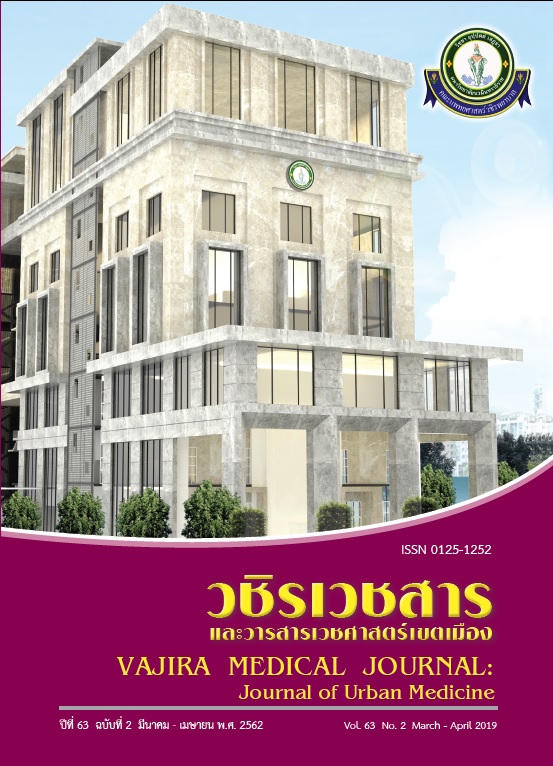Cutting Edge Innovative Surgical Strategies for Presbyopic Corrections
Main Article Content
Abstract
Presbyopia is typically affecting the quality of life of people from 40 years old of age, because of spectacle dependence for near task. Nowadays, the elderly population who requires high quality of vision in all range of distances without using spectacle continuously increases cross the globe. A number of publications focus on the surgical treatments for the correction of presbyopia however to reach the excellent outcome remains a challenge for refractive surgeons. Two main global popular surgical strategies categories for presbyopic correction are lens-based procedure, which replaces the natural lens by multifocal intraocular lens, and cornea-based procedure including PresbyLASIK and corneal inlays. PresbyLASIK is an advance type of laser-assisted in situ keratomileusis (LASIK) using excimer laser to create a multifocal corneal surface. Another option for presbyopic correction is corneal inlays which are implants placed in the corneal stroma of nondominant eye. This article focuses on cornea-based approaches in terms of principles, treatment outcomes and complications. Cutting Edge Innovative Surgical Strategies for Presbyopic Corrections
Downloads
Article Details
References
2. Accommodative and nonaccommodative treatment of presbyopia, Basic and clinical course American academy of ophthalmology section 13 refractive surgery; 2016-2017.
3. Gil-cazorla R, Shah S, Naroo SA. A review of the surgical options for the correction of presbyopia. Br J Ophthalmol. 2016;100:62-70.
4. Moussa K, Jehangir N, Mannis T, Wong WL, Moshirfar M. Corneal refractive procedures for the treatment of presbyopia. Open Ophthalmol J. 2017,11,59-75.
5. Thomas BC, Fitting A, Khoramnia R, Rabsilber TM, Auffarth GU, Holzer MP. Long-term outcomes of intrastromal femtosecond laser presbyopia correction: 3-year results. Br J Ophthalmol. 2016;100(11):1536-41.
6. Ackermann R, Kunert KS, Kammel R, Bischoff S, Buhren SC, Schubert H et al. Femtosecond laser treatment of the crystalline lens: a 1-year study of possible cataractogenesis in mimipigs. Graefes Arch Clin Exp Ophthalmol. 2011;249(10):1567-73.
7. Luft N, Siedlecki J, Sekundo W, Wertheimer C, Kreutzer TC, Mayer WJ et al. Small incision lenticular extraction (SMILE) monovision for presbyopia correction. Eur J Ophthalmol. Doi: 10.5301/ejo.5001069.
8. Vargas-Fragoso V, Alió JL. Corneal compensation of presbyopia: PresbyLASIK: an updated review. Eye Vis (Lond). 2017; 4:11. doi: 10.1186/s40662-017-0075-9.
9. Alió JL, Chaubard JJ, Caliz A, Sala E, Patel S. Correction of presbyopia by technovision central multifocal LASIK (presbyLASIK). J Refract Surg. 2006;22(5):453-60.
10. Baudu P, Penin F, Arba Mosquera S. Uncorrected binocular performance after biaspheric ablation profile for presbyopic corneal treatment using AMARIS with the PresbyMAX module. Am J Ophthalmol. 2013; 155(4):636-47.
11. Cosar CB, Sener AB. Supracor hyperopia and presbyopia correction: 6-month results. Eur J Ophthalmol. 2014;24(3):325-9.
12. Chan TC, Kwok PS, Jhanji V, Woo VC, Ng AL. Presbyopic Correction Using Monocular
Bi-aspheric Ablation Profile (PresbyMAX) in Hyperopic Eyes: 1-Year Outcomes. J Refract Surg. 2017;33:37-43.
13. El Danasoury AM, Gamaly TO, Hantera M. Multizone LASIK with peripheral near zone for correction of presbyopia in myopic and hyperopic eyes: 1-year results. J Refract Surg. 2009;25(3):296-305.
14. Epstein RL, Gurgos MA. Presbyopia treatment by monocular peripheral presbyLASIK. J Refract Surg. 2009;25(6):516-23.
15. Reinstein DZ, Carp GI, Archer TJ, Gobbe M. LASIK for presbyopia correction in emmetropic patients using aspheric ablation profiles and a micro-monovision protocol with the Carl Zeiss Meditec MEL 80 and VisuMax. J Refract Surg. 2012;
28(8):531-41. doi: 10.3928/1081597X-20120723-01.
16. Reinstein DZ, Archer TJ, Gobbe M. LASIK for Myopic Astigmatism and Presbyopia Using Non-Linear Aspheric Micro-Monovision with the Carl Zeiss Meditec MEL 80 Platform. J Refract Surg. 2011;27:23-37.
17. Reinstein DZ, Archer TJ, Gobbe M. Aspheric ablation profile for presbyopic corneal treatment using the MEL80 and CRS master laser blended vision module. J Emmetropia 2011,2(3);161-75.
18. Pallikaris IG, Panagopoulou SI. PresbyLASIK approach for the correction of presbyopia. Curr Opin Ophthalmol. 2015;26(4):265-72.
19. Zare Mehrjerdi MA, Mohebbi M, Zandian M. Review of Static Approaches to Surgical Correction of Presbyopia. J Ophthalmic Vis Res. 2017;12(4):413-8.
20. Limnopoulou AN, Bouzoukis DI, Kymionis GD, Panagopoulou SI, Plainis S, Pallikaris AI et al. Visual outcomes and safety of a refractive corneal inlay for presbyopia using femtosecond laser. J Refract Surg. 2013;29:12-8.
21. Garza EB, Gomez S, Chayet A, Dishler J. One-year safety and efficacy results of a hydrogel inlay to improve near vision in patients with emmetropic presbyopia. J Refract Surg. 2013;29(3):166-72.
22. Garza EB, Chayet A. Safety and efficacy of a hydrogel inlay with laser in situ keratomileusis to improve vision in myopic presbyopic patients: one-year results. J Cataract Refract Surg. 2015;41(2):306-12.
23. Verdoorn C. Comparison of a hydrogel corneal inlay and monovision laser in situ keratomileusis in presbyopic patients: focus on visual performance and optical quality. Clinical Ophthalmol. 2017;11:1727-34.
24. Moarefi MA, Bafna S, Wiley W. A Review of Presbyopia Treatment with Corneal Inlays. Ophthalmol Ther. 2017 Jun;6:55-65. doi: 10.1007/s40123-017-0085-7.
25. Moshirfar M, Desautels JD, Wallace RT, Koen N, Hoopes PC. Comparison of FDA safety and efficacy data for KAMRA and Raindrop corneal inlays. Int J Ophthalmol. 2017;10(9):1446-51.
26. Zhao J, Shen Y, Tian M, Sun L, Zhao Y, Zhang X, et al. Corneal Lenticule Allotransplantation After Femtosecond Laser Small Incision Lenticule Extraction in Rabbits. Cornea. 2017;36(2):222-8.


